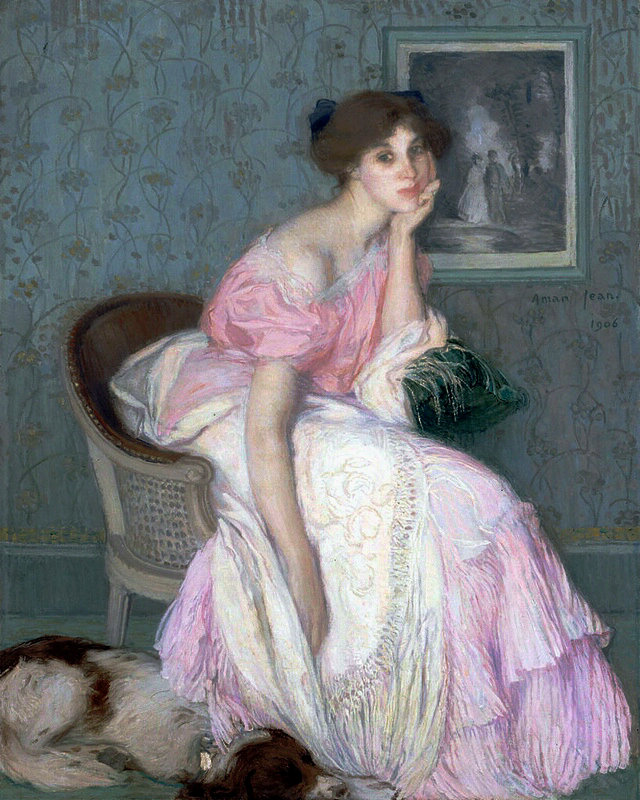Edmond Aman-Jean


Edmond François Aman-Jean (13 January 1858, Chevry-Cossigny – 25 January 1936, Paris) was a French symbolist painter, who co-founded the Salon des Tuileries in 1923.
Life
His father was the owner and operator of an industrial lime kiln. He had his first art lessons with Henri Lehmann at the École nationale supérieure des Beaux-Arts, where he shared a workshop with Georges Seurat. He also befriended the Symbolist painters, Alphonse Osbert and Alexandre Séon.
In 1886, he obtained a travelling scholarship and went to Italy, together with Henri-Jean Guillaume Martin and Ernest Laurent; studying the Old Masters. Along with Seurat, he worked as an assistant to Puvis de Chavannes, helping him to realize several of his murals. In 1892, he painted a portrait of the poet, Paul Verlaine, during his convalescence for syphilis at the Hôpital Broussais in the 14th arrondissement of Paris. Verlaine dedicated a sonnet to him and they remained good friends until Verlaine’s death in 1896.
He was also one of the first to recognize Joséphin Péladan as an important artist and exhibited at one of the first showings held at the Salon de la Rose + Croix. Later, he became an important teacher in his own right. His students included Charles Sydney Hopkinson, Theodor Pallady, and Nicolae Tonitza. In 1923, together with Albert Besnard and Auguste Rodin, he helped create the Salon des Tuileries. Ten years later, he was named a Commander in the Legion of Honour.
In 1892, he married Thadée Jacquet, the daughter of an Imperial Prefect, who was also a painter. They had two children, François, who became a well-known writer, and Céline, who was a painter and illustrator.
Art
Aman-Jean established his reputation primarily for his portraits, especially of female subjects; he was also noted for his murals in public and official buildings, including the Sorbonne. Like many French artists of his generation, he was influenced by the new perspectives on Japanese art current in Paris in his day; more unusually, he was interested in the Pre-Raphaelite artists in England.
He was a close friend of Georges Seurat; the two artists shared a Paris studio in 1879. Art historian Robert Herbert called Seurat’s portrait of Aman-Jean, “one of the great portrait drawings of the nineteenth century”. It was the first work Seurat showed, at the Paris Salon in 1883. Aman-Jean also worked in lithography and printmaking and designed posters.
Work
In the 1900s, without being part of it, he is close to the group of young painters of the “Black Band”.
Having shared a clear interest with Seurat and Séon for chromatic theories and divisionism, however, at the beginning of his career he practices a synthetism with dull colors. His taste for the fresco and tapestry, which is often compared his works of this period, inclines to paint without modeling, combining to dishes with subtle shades of decorative motifs.
Her inspiration lingers on figures of dreamy women with delicate attitudes. In 1896, Gustave Geffroy evoked his figures painted languidly in erased colorings, revived by a detail, a flower corsage or hair, too translucent eyes, enshrined as gems.
Works in public collections
In France
Brest, Museum of Fine Arts:
Sainte Geneviève in front of Paris, 1885, oil on canvas, 74 x 101 cm.
Dijon, Museum of Fine Arts:
Woman with glove, circa 1900-1902, pastel;
Portrait of Madame Ernest Chausson, 1902, oil on canvas, 125 x 104 cm
Portrait of Line, daughter of the artist, 1903, oil on canvas, 80 x 65 cm
Still life, circa 1905, oil on wood;
Woman in pink dress, pastel, 94 × 44 cm.
Gray (Haute-Saône), Baron-Martin Museum:
Young woman with blue eyes, pastel;
Woman with a white glove, circa 1905, pastel;
Young Woman with yellow scarf, or effects of floating sleeves, circa 1905, pastel;
Woman with straw hat, circa 1905, pastel;
Portrait of M. Edmond Pigalle, benefactor of the Museum, circa 1906, charcoal and pastel;
Nude study: the abandonment, around 1905, charcoal and watercolor on cardboard;
Study of a woman’s head, circa 1905, pastel, tempera and charcoal / white wood;
Portrait of a woman, circa 1907, charcoal and pastel;
Nude in hat, circa 1906, charcoal and pastel;
Nude with pergola, charcoal and pastel;
Girl with flowers, circa 1905, oil on canvas;
The stony, pastel.
The woman with the big hat and the white glove, lithograph;
Study of woman’s head, lithography;
The girl with flowers, lithograph.
Carcassonne, Museum of Fine Arts:
Saint Julien l’Hospitalier, 1882, oil on canvas, 360 x 270 cm.
Paris:
Small Palace:
Portrait of Sculptor Jean Dampt;
Portrait of Albert Besnard;
Miss Ella Carmichael.
Orsay museum:
Monseigneur Pierre-Louis Pechenard, 1916, oil on canvas;
Woman with the carnation, 1908, pastel.
Rouen, Museum of Fine Arts: Bather, oil on canvas, 92 × 73 cm.
In Romania
Bucharest, National Museum of Art of Romania: Confidences.
In Japan
Tokyo, National Museum of Western Art: Portrait of Mademoiselle Kuroki, 1922.
Source from Wikipedia